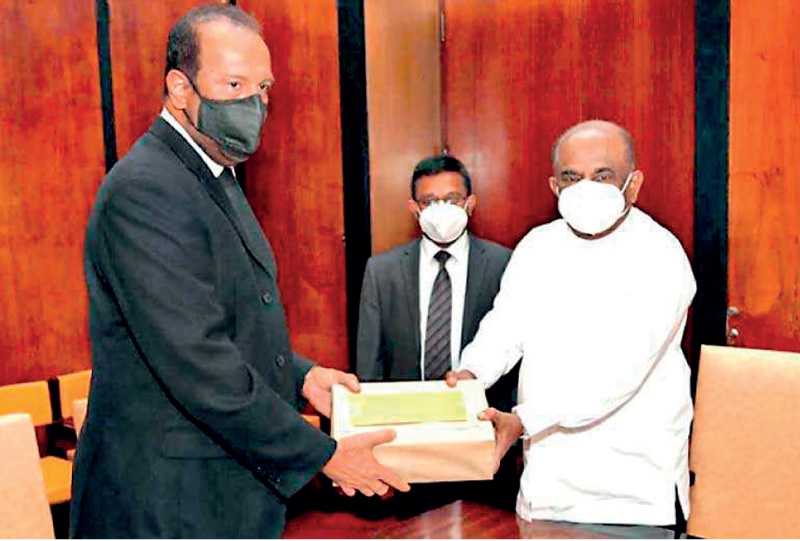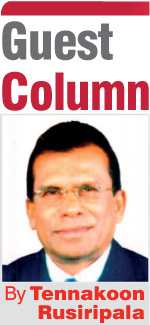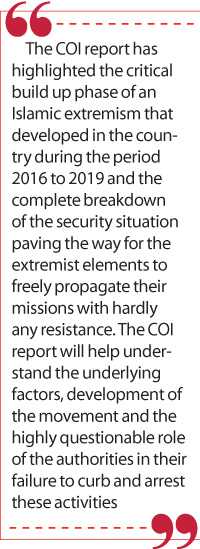Monday Mar 10, 2025
Monday Mar 10, 2025
Thursday, 4 March 2021 00:01 - - {{hitsCtrl.values.hits}}

After much dilly-dallying and drift the COI report has been tabled in Parliament and is now open to be viewed by all and sundry
 Talk of the town is currently centred on the recently released Presidential Commission Report on the Easter Sunday terrorist attack of 21 April 2019. After much dilly-dallying and drift the COI report has been tabled in Parliament and is now open to be viewed by all and sundry.
Talk of the town is currently centred on the recently released Presidential Commission Report on the Easter Sunday terrorist attack of 21 April 2019. After much dilly-dallying and drift the COI report has been tabled in Parliament and is now open to be viewed by all and sundry.
Before the release it passed through a few noteworthy wayposts, some discreetly discussed. The COI report was referred to a committee of politicos creating a rumpus with accusations of ostensible attempts to shelve it further for some unknown pursuit. Reportedly, it was also subject to certain behind the scene manoeuvres by those who feared and anticipated adversities forthcoming. But the pressure built up from decisive sources for its early release made it happen in the end.
Many have not yet had proper access to the report. Therefore, it is difficult to apprehend the propriety of certain comments made about the contents and the intents of those making such remarks. However, scrutiny indicates that many utterances against the report are either self- centred or highly tainted with ulterior motives. Hence an unprejudiced review is the most desired in the context.
Our history of Commission Reports is not very cheerful. COIs and similar bodies established by successive Sri Lankan governments have been ineffective and deeply deficient in terms of their mandate, functions and independence. As many have previously commented, such mechanisms have largely been partisan stratagems for punishing political opponents or for shielding perpetrators and institutions from responsibility. But not all. This Commission has a uniqueness in that it was appointed during one regime, continued its deliberations through it for some time and finally concluded during the period of a successive government. The other distinctiveness of this report is that it is smeared with unfavourable references to its originators.
A short history of commissions in our country
We could trace a few to refresh our memories.
The first important footprint recorded in our history is the appointment of the ‘Solebury Commission’ on 5 July 1944, under the British rule in response to an initiative by a group of patriots headed by Right Hon. D.S. Senanayake, for the establishment of a new Constitution for Sri Lanka. This marked an important milestone in the struggle launched by our people towards the achievement of independence to the country.
Following the eventful regime change that took place in the country in 1977, President J.R. Jayewardene established a Commission of Inquiry, under a warrant dated 29 March 1978, about the alleged abuse of emergency powers, corruption and nepotism by Mrs. Bandaranaike and some of her ministers and officials. The ex-prime minister applied for a writ to the Appeal Court to restrain the commission from proceeding against her, stating that under the Constitution, as prime minister, she was answerable only to Parliament.
The Appeal Court held with Bandaranaike and the commission became defunct. But then events took a new turn. The Government brought in an amendment to the Special Presidential Commissions Act giving retrospective power to the commission, re-validating all past proceedings before it and declaring the Appeal Court’s order null and void. What transpired thereafter is part of the history now. It resulted in depriving the civic rights of former Prime Minister Sirimavo Bandaranaike, Minister Felix Dias Bandaranaike and a few other officials.
This was followed by a few other Commissions which were considered as highly controversial by the public during the tenure of the J.R. regime.
The commission which examined an infamous coup d’etat, ‘nicknamed’ the ‘lavatory coup’ ended up by imprisoning several convicted to jail sentences including most venerable Henpitagedara Gnanaseeha thero;
Investigation into the alleged conspiracy to assassinate the President and planned violence on 20/10/1982 against Vijaya Kumaranatunga and others following the first presidential election of the country;
Commission appointed by president Chandrika Bandaranaike to “inquire into the establishment and maintenance of places of unlawful detention and torture chambers at the Batalanda housing scheme”. Leader of the opposition Ranil Wickremesinghe was summoned before this commission;
In February 1996, President Chandrika Bandaranaike appointed another Presidential Commission to Inquire into the Assassination of Vijaya Kumaranatunga;
More recently, the Commission of inquiry appointed to examine the Central Bank Bond Scam, and the Commission of Inquiry established by the Yahapalana Government to inquire into the allegations of bribery, corruption and misuse of public property by Ministers, MPs and officials of the Rajapaksa regime.
These are some of the commissions which received unprecedented attention of the General Public with wide publicity given to the proceedings by the media.
The JVP uprise in 1971 is another event in the history of this country which attracted highest public attention. It was adjudicated under a specially set up Criminal Justice Commission. All knew that the incidents involved bomb attacks, destruction of public property, killing of civilians and service personnel including their family members, attacks launched on several police stations using bombs and fire arms and rebels holding power in certain areas of the country (e.g. Elpitiya police area kingdom of the JVP) until liberated by state forces.
There was widespread speculation that some foreign force was behind this uprise. However, when it was finally subdued and suppressed after the arrest and annihilation of several, there was no cry to locate or trace any masterminds or foreign financiers behind. It was accepted as a homegrown struggle influenced by international politics but with no direct hands behind.
All these Commissions ended up with no semblance of any masterminds behind being detected. There was also no hue and cry for such a requirement.
We also witnessed how the much sought-after Bond Scam report vaporised into thin air due to a highly technical objection raised by TNA MP Sumanthiram, when it was due to be tabled in Parliament, for the want of a mandatory Tamil translation. To-date the matter rests there. Lists of names of bribe takers, receivers of high value gratifications from the culprits have gone down the drain to be forgotten forever. Both Government and opposition seem to have entered into an understanding bartering to mutually agree to suppress two highly controversial commission reports affecting both sides.
Easter Sunday COI report highlights
In the light of this historical background let us take a critical look at the Easter Sunday COI.
When the bomb attack of 21 April 2019 took place there was no President ‘or’ a Defence Minister present in the country. Not even in an acting capacity.
The Defence Secretary appointed by the President claims that he had no direct access to the President or he has been distanced from the President to an extent that there was hardly any communication between them. The National Security Council was not meeting regularly. According to the COI report, the NSC has met only on four occasions during a period of six months preceding the easter Sunday attack (between 30-10-2018 and 22-4-2019).
Although the Defence Secretary claims that the President and he were hardly talking to each other, records indicate the following highly incredible exceptional entrusting of responsibilities to Hemasiri Fernando (defence secretary) during this period.
Fernando was appointed as the Defence Secretary by the President on 30-10-2018, while serving as the Chairman of People’s Bank where he continued until his resignation in April 2019. He was the Chief of Staff of the Presidential Secretariat till 7 November 2018. He served as the Chairman of the BOI till March 2019. He was also the Chairman of Railway Museum committee (extracts from the COI report).
Isn’t this state of affairs highly unusual and incredible? And it is all the more intriguing how a person holding so many vulnerable, sensitive high posts be kept at a distance from reach by the President?
History of the events preceding the appointment of the COI too pose many questions. President Sirisena who returns to the country from Singapore after the Easter Sunday attack decides to appoint a three-member committee to advise on the best course of action needed to be taken in this regard headed by President’s Counsel and Judge Vijitha Malalgoda. This committee recommends the appointment of a Presidential Commission of Inquiry into the matter.
While this is pending the Parliament decides to appoint a Parliament Select Committee to investigate the matter. It also decides that the proceedings of this PSC should be made open to the media so that the people get first-hand information live, while the sittings of the PSC proceed. MPs of several parties including JVP, UNP and TNA are appointed to this. Inquiry commences. Parties are summoned before the PSC and its members question them.
Although the PSC announced and agreed to release the proceedings live at some stage, they question the witnesses in camera. A senior police officer is questioned at a place outside the Parliament for several hours. Public watch it as a mock trial of some sort. After several days of meeting the PSC concludes its sittings but with no conclusive indication of the background, mastermind or any external sources responsible. However, the PSC painted a picture to indicate that names of certain political figures in the Government strongly conjectured by the public to have had some connections to the incident are not responsible.
It is in this background that President Sirisena appointed the COI. A public notification along with a Gazette notification is published in the media announcing the appointment of the COI and calling for public representations and information. Notice reads as follows; ‘Presidential Commission of Inquiry to investigate and inquire into and report or take necessary action on the bomb attacks on 21 April 2019.’
The notice sets out the framework of the investigation process and the purview of the COI under 13 headings. Basically, they deal with the public views, complaints information and other materials against public servants/officers or other persons who were or are working or any other persons who are alleged to have direct or indirect connections to the bomb explosion that took place on 21 April 2019. The notice specifically stated:
“To hold prompt, impartial, complete investigations and inquiries regarding complaints, information;
To identify persons and organisations who are directly or indirectly connected to these terrorist acts;”
COI started its work on 1 October 2019. The task of the COI was slightly affected due to the Presidential Election which was followed by the General Election and the pandemic situation in the country. One of the important steps followed by the COI during the inquiry is to physically visit places for a better understanding of the evidence.
The COI report has highlighted the critical build up phase of an Islamic extremism that developed in the country during the period 2016 to 2019 and the complete breakdown of the security situation paving the way for the extremist elements to freely propagate their missions with hardly any resistance. The COI report will help understand the underlying factors, development of the movement and the highly questionable role of the authorities in their failure to curb and arrest these activities.
The highly politicised approach displayed by our legislators has contributed in a big way towards the precipitation of the eventful happenings. The first volume of the report has outlined factually determined material, on the basis of evidence before the COI. A careful study of these will help the public understand the background and the factual situation underlying the episode. I wish to deal in detail with some of the highly relevant disclosures as a continuation of this write up because it is too lengthy to be covered in one article.
There are many aspects to be covered. The COI report, however, provides answers to many relevant issues discussed in this regard. The best way is to reproduce extracts from the report of the sections that deal with FAQs and areas of concern by the public. I have started it and will be included in the next part.
Discover Kapruka, the leading online shopping platform in Sri Lanka, where you can conveniently send Gifts and Flowers to your loved ones for any event including Valentine ’s Day. Explore a wide range of popular Shopping Categories on Kapruka, including Toys, Groceries, Electronics, Birthday Cakes, Fruits, Chocolates, Flower Bouquets, Clothing, Watches, Lingerie, Gift Sets and Jewellery. Also if you’re interested in selling with Kapruka, Partner Central by Kapruka is the best solution to start with. Moreover, through Kapruka Global Shop, you can also enjoy the convenience of purchasing products from renowned platforms like Amazon and eBay and have them delivered to Sri Lanka.
Discover Kapruka, the leading online shopping platform in Sri Lanka, where you can conveniently send Gifts and Flowers to your loved ones for any event including Valentine ’s Day. Explore a wide range of popular Shopping Categories on Kapruka, including Toys, Groceries, Electronics, Birthday Cakes, Fruits, Chocolates, Flower Bouquets, Clothing, Watches, Lingerie, Gift Sets and Jewellery. Also if you’re interested in selling with Kapruka, Partner Central by Kapruka is the best solution to start with. Moreover, through Kapruka Global Shop, you can also enjoy the convenience of purchasing products from renowned platforms like Amazon and eBay and have them delivered to Sri Lanka.